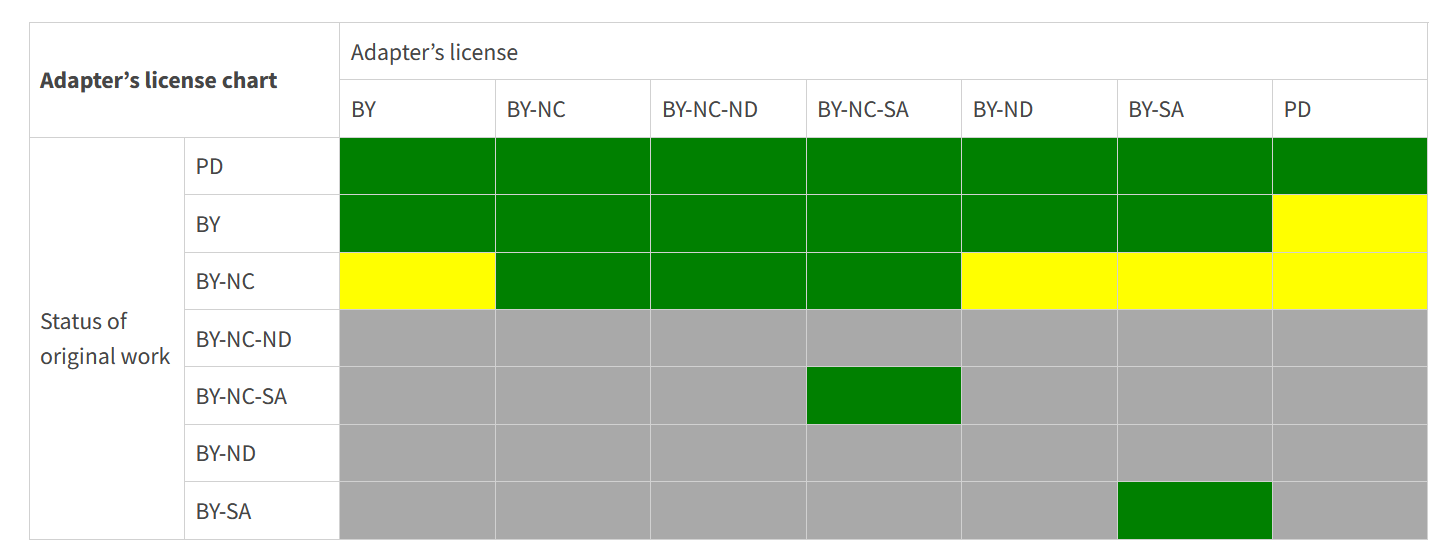
"Creative Common licenses (CC) are legal tools that creators and other rights holders can use to offer certain usage rights to the public, while reserving other rights. Those who want to make their work available to the public for limited kinds of uses while preserving their copyright may want to consider using CC licenses" (Creative Commons, 2020).
This video made by the University of Guelph Library helps explain some of the main ideas behind Creative Commons.
"What are Creative Commons Licenses?" by University of Guelph Library is licensed under CC BY-SA 4.0
Text reproduced from Creative Commons - About the licenses
|
CC0 “No Rights Reserved” |
CC0 enables scientists, educators, artists and other creators and owners of copyright- or database-protected content to waive those interests in their works and thereby place them as completely as possible in the public domain, so that others may freely build upon, enhance and reuse the works for any purposes without restriction under copyright or database law. See more. |
|
This license lets others distribute, remix, adapt, and build upon your work, even commercially, as long as they credit you for the original creation. This is the most accommodating of licenses offered. Recommended for maximum dissemination and use of licensed materials. |
|
|
This license lets others remix, adapt, and build upon your work even for commercial purposes, as long as they credit you and license their new creations under the identical terms. This license is often compared to “copyleft” free and open source software licenses. All new works based on yours will carry the same license, so any derivatives will also allow commercial use. This is the license used by Wikipedia, and is recommended for materials that would benefit from incorporating content from Wikipedia and similarly licensed projects. |
|
|
This license lets others reuse the work for any purpose, including commercially; however, it cannot be shared with others in adapted form, and credit must be provided to you. |
|
|
This license lets others remix, adapt, and build upon your work non-commercially, and although their new works must also acknowledge you and be non-commercial, they don’t have to license their derivative works on the same terms. |
|
|
This license lets others remix, adapt, and build upon your work non-commercially, as long as they credit you and license their new creations under the identical terms. |
|
|
This license is the most restrictive of our six main licenses, only allowing others to download your works and share them with others as long as they credit you, but they can’t change them in any way or use them commercially. |
Citations and attributions serve similar purposes in the sense they are used to give credit to the original creators of information. However, there are some differences in when they should be used.
A citation allows authors to provide the source of any quotations, ideas, and information that they include in their own work based on the copyrighted works of other authors.
Attribution is the cornerstone condition when using a resource or text released with an open-copyright licence. This legal requirement states that users must attribute — give credit — to the creator of the work.
These definitions are taken from Citation vs. Attribution by Lauri Aesoph is licensed under a Creative Commons Attribution 4.0 International License, except where otherwise noted.
Open Text BC provides more information on this difference at https://opentextbc.ca/selfpublishguide/chapter/citation-vs-attribution/
The ideal CC attribution should contain:
Example: “Furggelen afterglow” by Lukas Schlagenhauf is licensed under CC BY-ND 2.0.
Different Creative Commons licences allow for different rights in terms of use, distribution, and adaptation. Check the graph below to see what each licence allows.

"Creative Commons Licenses" by JoKalliauer, is licensed with CC BY-SA 3.0
Using multiple openly licenced works to create something new can be exciting, but you also need to consider certain aspects regarding each licence and whether they do allow for modifications and remixes. Check this page for more information.
When the adaptation includes more than one CC licensed work, the licensing compatibility also must be observed before a creator can choose a license for her own contribution (the "adapter's license). The chart below describes which CC licenses can be chosen as an adapter's license. The licenses in green are fully compatible, while the ones in grey are not. Choosing a license corresponding to the yellow boxes is not recommended, though technically allowed by the terms of the license.
 "Adapter's license chart" extracted from Creative Commons FAQ
"Adapter's license chart" extracted from Creative Commons FAQ